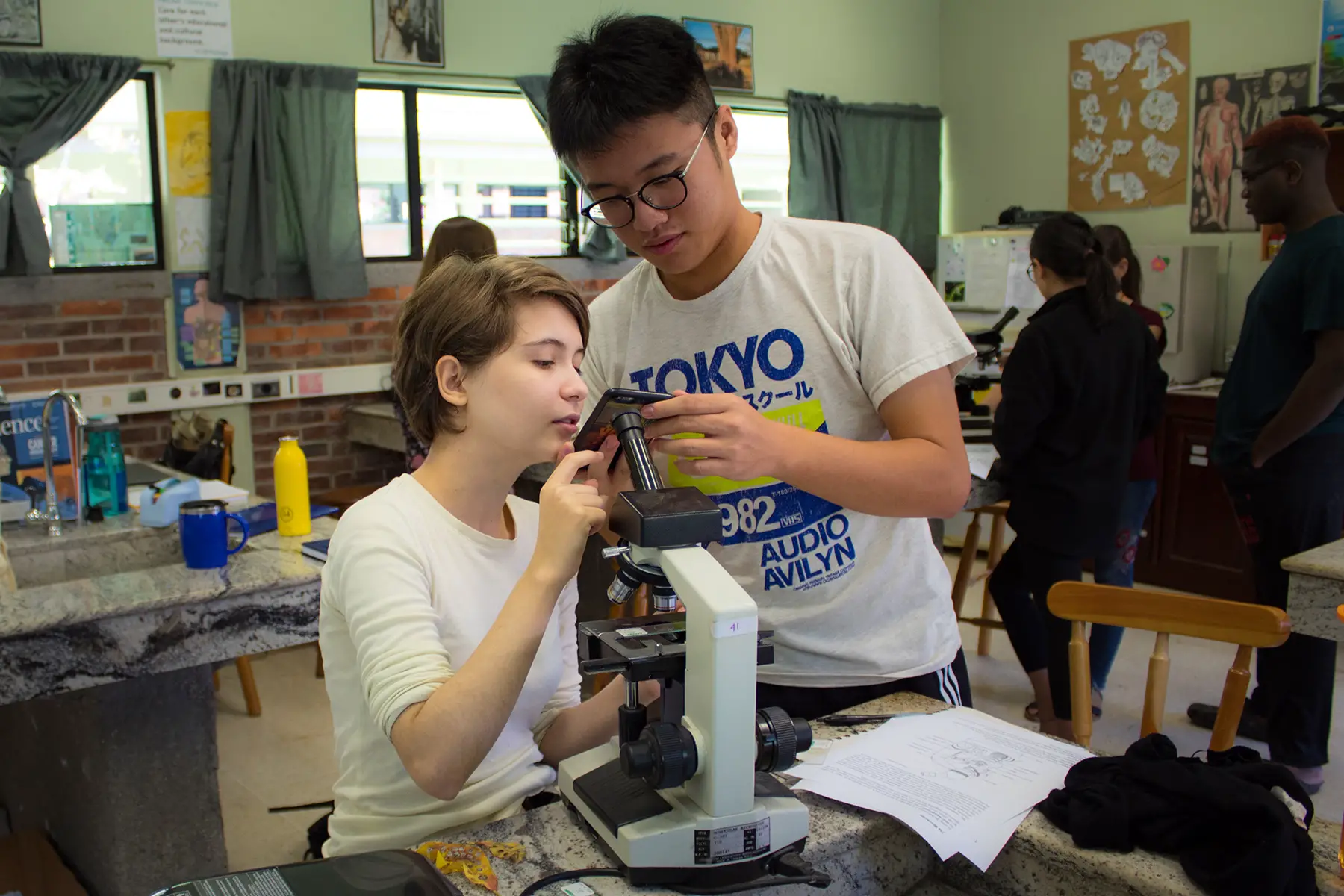If you’re moving to Germany with children in tow, you’ll find that the German education system consists of many quality local schools as well as a number of private and international schools catering for expat children.
This guide to international schools in Germany will help you decide on the best option for your children. It features sections on:
Bavarian International School (BIS)
Give your child the best start in life with Bavarian International School. With two campuses in and around Munich, this English-language school aims to inspire young, curious minds from Kindergarten to Grade 12 through its IB curriculum. BIS also offers many out-of-hours activities for personalities to flourish holistically.
The German education system
Germany provides a good quality education system overall, with many respected institutions at all levels. According to the 2018 OECD/PISA survey of standards among 15-year-olds, the country ranked 20th in the world in reading and mathematics, and 16th in science.
Schooling in Germany is compulsory between ages 6-15. There is a mix of state-run, private and international schools in Germany. Children attend primary school until the age of 10, then will progress to one of four types of secondary school based on academic performance, teacher recommendations and parent preferences.
International schools in Germany
International schools in Germany are mostly privately-run institutions, although there are a few that are part of the public system. There are a number of these schools across the states offering an alternative to public schooling at both primary and secondary level, although fees vary. Most of these schools are in bigger cities where expats are more populous.
Most international schools in Germany have small class sizes, excellent facilities and high educational standards. They tend to have a more multicultural mix of pupils than state schools and teach mainly in English, although some schools are bilingual (with German, French, Italian and Spanish the most common non-English languages).
These schools tend to follow slightly different international curriculums, but are not vastly different from state schools in Germany. Most schools are day schools, although some offer boarding. Religious schools and method schools (such as Montessori schools) can also be found.

International schools are subject to the same regulations as public schools. These are mainly administered at individual state level. The right to set up a private international school is enshrined in German Basic Law but it must be approved by the state, and teachers need to be trained to the same standard.
Many international schools in Germany take in pupils at kindergarten level and teach them until the end of compulsory secondary schooling, although you can also find separate primary and secondary schools.
The best international schools in Germany are affiliated with the Association of German International Schools (AGIS), or are accredited by either the Council of International Schools (CIS) or the New England Association of Schools & Colleges (NEASC).
International school curriculums and certificates in Germany
Most of the international schools in Germany offer one or more of the following curriculums:
- International Baccalaureate (IB) Primary Years, Middle Years and IB Diploma programs;
- UK-based International General Certificate of Secondary Education (IGCSE);
- US-based High School Diploma and Advanced Placement (AP)
Some schools follow other national systems, for example the French Lycee Jean Renoir in Munich and the Japanese School in Hamburg. Method schools follow their own curriculum. Some international schools may offer the German Abitur.
International Primary Curriculum (IPC) and International Baccalaureate (IB)
Over 5,100 schools in 157 countries worldwide offer IB programs. There are three main programs, which are:
- Primary Years Program (PYP) – taught to pupils aged 3-11 and consisting of six core subjects (language, maths, social studies, science, art, physical education);
- Middle Years Program (MYP) – taught to pupils aged 11-16, expanding on subject areas and built around eight core subjects (same as PYP but with literature and design added);
- IB Diploma – this is a pre-university program where students study six subjects, take an additional philosophy course on the theory of knowledge, write a 4,000-word essay on a topic of their choice and complete 150 hours of work outside the classroom contributing to creativity, action and service.

Some schools may offer the International Primary Curriculum (IPC) during early years. This is an internationally-renowned syllabus taught in over 700 international schools in over 70 countries.
International GCSE (IGCSE)
The IGCSE is a UK-based qualification administered by different exam boards such as London (Edexcel) or Cambridge. It is equivalent to GCSE qualifications in UK schools.
Schools teach the IGCSE to secondary school students during years 10 and 11, and give exams at the end of year 11 (when students are 14–15). Students achieve grades for individual subjects, ranging from 9 (highest) to 1 (lowest) in each subject. Pupils have compulsory subjects, such as maths and English, and can study chosen subjects (e.g., history, art).
IGCSE qualifications can take you onto the first stage of post-compulsory higher education, such as the IB Diploma or A Levels.
American High School Diploma and Advanced Placement
Some schools offer a US-based program leading to the High School Diploma. This starts in year 8 or 9 of schooling and finishes with exams at the end of year 12. Coursework is also involved. Students study subjects relating to maths, science, humanities, English literature and the arts. Additional optional specialty subjects are also available.
Students can then progress to Advanced Placement college-level study where they can choose from a selection of subjects and sit exams for university entrance. Exam grades range from 5 (highest) to 1 (lowest).
Should you send your child to an international school in Germany?
Whether or not you choose to send your child to an international school in Germany will depend on personal circumstances and a number of factors. There are both pros and cons of enrolling in an international institution.
Advantages of international schools in Germany
- Continuity of education – children who have begun their education back home can continue to be taught in a curriculum they understand, in their first language. This can be very beneficial for families who travel around a lot, especially if they might not be looking to stay in Germany for a long period.
- Multicultural environment – international schooling gets kids used to mixing with and befriending people from a wide range of backgrounds. These schools can sometimes have pupils from 50+ different countries.
- Smaller class sizes – international schools are more easily able to limit pupil intake so have a lower pupil to teacher ratio. This means that teachers can give more time to children, especially those who may need additional support.
- Quality of teaching – international schools are generally known for their high standards and caliber of teachers. Students that leave school with IB or IGCSE qualifications will be in a good position to progress to further education in Germany or elsewhere.
- Extracurricular activities – international schools often offer a wider range of sports, artistic and social activities during both term time and holiday periods.

Disadvantages of international schools in Germany
- Costs – whereas state schooling in Germany can be accessed for free, most international schools will charge annual fees. These can be expensive, so you will need to consider whether the expense is affordable and worthwhile.
- Entry requirements – admissions procedures vary from school to school but they are usually more rigorous than for state schools. Furthermore, there may be waiting lists meaning that you will have to apply earlier. Examinations and interviews are both common parts of the application process.
- Less integration – enrolling your child to an international school in Germany will probably mean that they integrate more slowly with German life and culture. Because lessons are typically in English rather than German, they will also have less chance to learn the language.
Admission procedures vary from school to school but it is best to apply as soon as possible as there are often waiting lists. You might, however, be able to gain admission part way through a year as the student population in international schools can be transient.
How to choose an international school in Germany
Beyond basic considerations such as cost, there are a number of things you might want to consider when choosing from the many international schools in Germany. These can include:
- Reputation – What kind of feedback has it had and does it have any links with top universities?
- Facilities – what are the classrooms, libraries and sports facilities like? Has the school invested sufficiently in technology?
- Extra-curricular activities – what is on offer?
- Teacher turnover – if the turnover rate is low, this could be a sign that the school values its staff and pupils.
- Culture and values – Do the overall aims and values chime with your own? If you’re into sustainability, check out a school that participates in the Eco-Schools program. For example, Munich International School offers students a hands-on environmental education in addition to traditional curriculum.
Types of international schools in Germany
International Baccalaureate (IB) schools
There are currently 82 IB schools in Germany. This includes 27 schools teaching the PYP, 15 schools teaching the MYP, 77 schools teaching the IB diploma, and five schools teaching the career-related program.
IB schools or schools that offer the IB program in Germany include:
Most IB schools in Germany teach primarily in English, with some also offering lessons taught in German. The teaching approach and culture will vary from school to school.
Fees also vary across schools and grade levels. There is no state funding for international schools in Germany but individual schools often have fee reductions for a limited number of students from low-income families each year. Some may also have scholarship programs.
In addition to tuition fees, IB schools usually charge a number of other fees which can include for things such as registration, entrance, equipment, after-school activities and transport.
Many IB schools end up over-subscribed. Because of this, it’s advisable to apply as early as possible. Application processes often involve an entry test and you will usually have to pay a non-refundable application fee of around €200-300.
American international schools
Many of the American international schools that primarily served US military families based in Germany through the Department of Defense Education Activity (DoDEA) post-war program have recently closed, and only a handful remain. There are several international schools that offer the High School Diploma alongside the IB curriculum, but the US-based curriculum is nowhere near as widely taught in Germany as the IB ones.
American schools in Germany cater largely for children of US Department of Defense employees stationed in Germany, although most offer a limited number of yearly placements to other German and international pupils.
These schools are mostly bilingual, teaching in both English and German. Some offer the German Abitur. The John F Kennedy School is non-fee paying and is integrated within the German state educational system. Application procedures vary between schools.
British international schools
A number of international schools in Germany offer IGCSE programs alongside the IB curriculum. In addition to this, there are three renowned British schools that primarily teach the English national curriculum leading onto the IB Diploma for those that want to continue their education.
These schools are:
- Berlin British School
- St George’s The British International School (with three schools based in Cologne, Düsseldorf, and Munich)
All three of these schools provide an education influenced by British teaching methods, standards, and culture to pupils of all ages from early years through to year 12. The Cologne campus at St George’s also offers boarding.
Tuition fees are on a sliding scale as learning progresses. For example, costs at the Berlin British School range from around €6,000 per year for early years to over €15,000 a year for year 12.
Both schools offer a limited number of scholarships and bursaries to students meeting eligibility criteria. Admissions information and details on how to apply are given on the school websites.
Other national international schools
Several other countries have set up schools in Germany, with France in particular having established institutions in a number of German states.
These schools are typically bilingual, teaching in their mother tongue and German. Fees, funding, applications processes and other educational and non-educational aspects of schools with vary from institution to institution. All information can usually be found on individual school websites.
Examples of these schools include:
- Česká škola bez hranic (Czech school in Munich)
- Grundschule Dohrnstrasse (German-Italian school in Hamburg)
- Grundschule Lutterothstrasse (German-Spanish school in Hamburg)
- Japanese School in Hamburg
- Lycee Jean Renoir (French school in Munich)
Religious schools in Germany
Religious schools exist in Germany, although many are reliant on state funding. Christian schools are the most populous. There are also a few Islamic and Jewish schools.
Some religious schools, such as the Black Forest Academy Christian boarding school in Kandern, operate similarly to other international schools in that they are fee-paying, teach primarily in English and offer places to students of all faiths and none. There are also schools that teach mainly in German.

Availability of religious schools in Germany, as well as school culture and operational procedures, varies from state to state. Schools include:
- Islamic Grundschule, Berlin
- Philanthropin Jewish School, Frankfurt
- St Pius Roman Catholic Gymnasium, Munster
Method schools in Germany
There are two main types of method school in Germany. The Waldorfschule, based on the philosophy of Rudolph Steiner, and Montessori schools. In addition to this, there are around 80 independent alternative schools.
Waldorfschule in Germany number around 200. They offer primary and secondary education based around the concept of anthroposophy, which views artistic activity and development of the imagination as central to learning. Non-traditional lessons such as gardening and mythology are included in the syllabus.
There are around 270 Montessori schools in Germany, based on the teaching methods of Maria Montessori. These schools offer a child-centered approach focused on a “constructivist” model, where students learn through working with materials rather than by direct instruction.
Although using distinct teaching methods, Montessori schools and Waldorfschule vary between institutions. Some are privately run while others are state-funded. Many teach primarily in German but there are schools that offer an English-taught curriculum. Full details can be found on individual school websites.
Montessori schools in Germany include:
- Anna-Schmidt-Schule, Frankfurt
- Montessori Oberschule Potsdam
Waldorfschule schools in Germany include:
- Rudolph Steiner Schule Berlin
- Parzival Schule Munchen
Useful resources
- Council of International Schools – information on international schools in Germany and worldwide
- International Schools Database – database for all of Germany’s international schools








